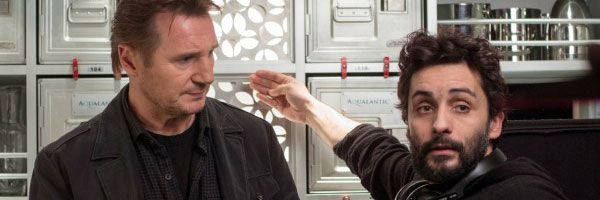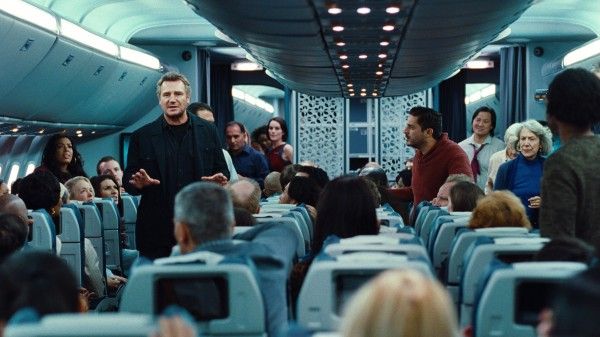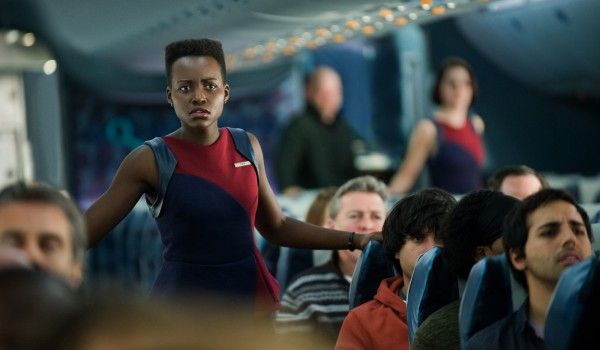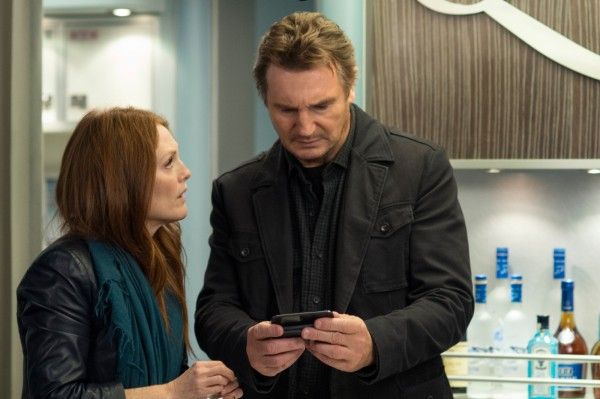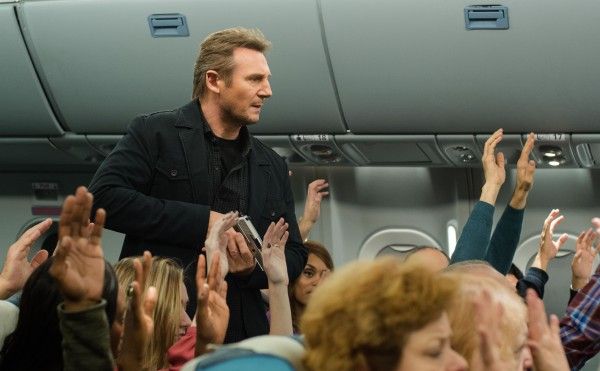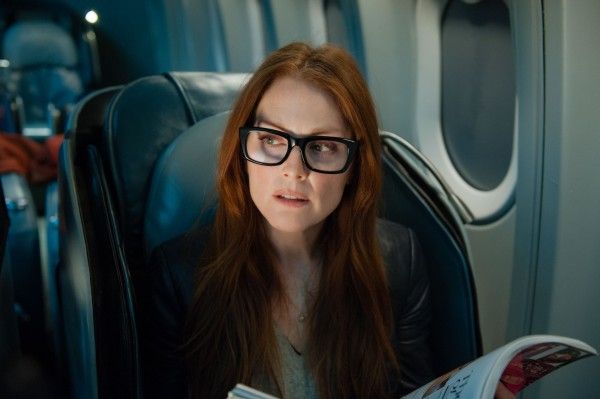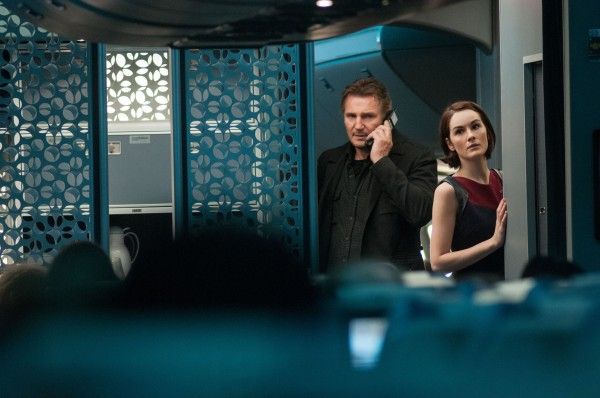With Jaume Collet-Serra’s exciting action thriller Non-Stop starring Liam Neeson
now available on Blu-ray/DVD, I recently covered a fun press day at Air Hollywood to promote the release. Located in the San Fernando Valley, Air Hollywood is the world’s largest aviation-themed studio and has worked with every major studio and production company in Hollywood and beyond, providing sets, props, interior plane mock-ups, cockpits of all shapes and sizes, and even a standing airport terminal set. Other recent movies that have used their services include Bridesmaids, Flight, Warm Bodies, Baggage Claim, The Wolf of Wall Street, and Million Dollar Arm. Besides providing production friendly facilities, Air Hollywood also holds Fear of Flying classes, and recently launched the Open Sky for Autism program to assist families with autism in acclimating to air travel.
Our First Class adventure began onboard a 737 mock-up with the screening of a hilarious flight safety video spoofing key scenes from Non-Stop. It was followed by a fascinating presentation by director Collet-Serra and art director David Swayze who used art and production stills from the movie to show how they choreographed original and exciting action in a confined space and were able to capture some of the cool shots. Next was a brief Q&A that ended with an air turbulence simulation (without seatbelts!) followed by a personal tour of the facilities with Air Hollywood CEO Talaat Captan and COO Rob Shalhoub who showed us their extensive prop shop, other mock-up sets, the cockpit from the Lakers Champion Air airplane, and the original cockpit used in the 1980’s comedy, Airplane! Hit the jump to read the presentation and Q&A.
JAUME COLLET-SERRA: First, I want to talk about why we made this movie. For a director that likes thrillers like me and is a fan of directors like Hitchcock or Polanski, there’s always the great challenge of doing a movie, a thriller, in one confined space. I am terrified of airplanes. I don’t fly very well. When I read the script, even though the script was not perfect, I felt that there was a rare opportunity to do something that was scary and also like an Agatha Christie mystery novel. We’ve seen airplane movies before, mostly disaster movies, where you have to deal with the plane crashing, or you have to deal with terrorists, or executive decisions where there was that awesome scene with a plane next to the other plane and they’re transferring people. I mean absurd stuff. I wanted to do something that was more realistic, where people get on a plane every day and are always wondering, “Who is sitting next to me?” Obviously, with the post-9/11 psychology of the world, I thought that it was a great opportunity to do something that was very mysterious. So, that’s the main reason – dealing with a confined space, trying to get over my fear of flying, and doing something that was mysterious.
When I got the script, the script was full of problems as usually happens. You have a great concept. You have a great actor like Liam, who also, like me, saw the concept and the potential of it, but it needed a lot of work. The reason why I’m saying that in relationship to what we’re going to be talking about is because when we shoot a movie, the script is never really done until you start the movie. Normally, it’s not a big problem because you adapt. “Oh, we wrote a new scene. Let’s find that location. We wrote this. We found that actor.” Here, it was much more difficult because they were already building the plane. So, as the script evolves, the plane is being built at the same time, and that really drove these guys crazy. (to Swayze) How long does it take to build a plane?
DAVID SWAYZE: We had 10 weeks to do the whole thing.
COLLET-SERRA: The first thing that I had to decide was what kind of plane it was. We landed on a 737.
SWAYZE: We matched it all up, because it needed to fulfill [the requirements of the script]. It’s one of the complex things about designing something that people are so familiar with, like something you’re sitting in now. Everyone travels in their life. They have expectations for what an airplane looks like. But we’re also building this machine that’s going to serve to function the locked box mystery that Jaume was talking about. We needed to take liberties with where people are, how they are, and also to make it a dynamic space. A plane can be very literal. You walk up the aisle. You walk down the aisle. We needed to make a space that had places where we could have Liam confined, privacy where he could have asides, where we could make this mystery feasible while not setting off any alarms where audiences would go, “Well that’s not an airplane.” We built the whole plane from scratch. We didn’t buy it. We didn’t rent it. We bought parts of it. We made something that was a combination of wide bodied airplanes and allowed Jaume enough room to get around and also to create the counter lines that he wanted, with a major central aisle in Coach and a very spread out, very opulent First Class that allowed for those little pockets of dialogue to happen.
COLLET-SERRA: I wanted a plane that had a Business/First Class, which is something that you get these days. Back in the days, it used to be more like -- I mean there are still some planes that have First, Business and then Coach. But the first decision was to make it a two-class airplane with two aisles on each section, so for practical purposes I could have people running up one aisle and then the camera on the other obviously. Our aisle was much tighter than this. We designed the aisle. We took the tape measure from the smallest dolly we could find, and that was the aisle, which was slightly wider than normal but not too much. Going back to what I was saying about the script and the design of the plane and how complicated that was, there is this one shot where we go around the plane three times. I had the crazy idea that I wanted to do 8 minutes in one shot.
SWAYZE: We were all very enthusiastic. (Laughter)
COLLET-SERRA: Yes. Basically, there was a part in the script that was very slow for me, which was him searching the passengers. It was something that I could see taking a long time to shoot and then not being interesting, because people just want to go and find the bad guys. I need to do something visual that was more interesting, and I said, “Maybe we’ll just do one shot and go outside and come around.” The key thing to do a one-shot is that you need to know exactly where everybody is sitting to design that shot. While the script was being written, I had to figure out where every main character was sitting.
SWAYZE: We had a seating chart.
COLLET-SERRA: We had to know where everybody was sitting, like every character and every extra, so I could design the shot. According to my shot, I would change where people were sitting so you would be able to find them, and I could do that with the camera. The reason why I’m saying that is because that crazy shot basically locked those people into those places for the rest of the movie. I did it backwards. It’s not like I said, “Those people sit there. Now we’ll design the shot.” No. I designed the shot and then that’s where those people were. A lot of the things that we designed on the plane were to make that shot possible. And then, the scenes and everything were informed after that.
SWAYZE: It’s like a little ballet. There were walls coming up, walls going back down, the camera coming around, and seats getting pulled out of the way and pushed back in the way. It was a choreography between [all those] because you didn’t want to cut any more than you had to, and you didn’t have to.
COLLET-SERRA: Right. It was very complex, because once you have those people in their seats, then you have to make sure that’s where they are in every scene. For instance, the cop played by Corey Stoll, I still remember he was in seat 22C. (Laughter) It was back here (pointing to the seating chart on display). Then, if you remember the first time that we introduced him sitting is when he notices that Liam goes up this aisle to meet the other Air Marshal. Basically, because I wanted to introduce him with Liam, Liam had to go down this aisle. Had he been sitting here, I would have switched Liam going down this aisle and then put Corey here. You can see the domino effect of where everybody is sitting and how it affected every other scene in the movie. One of the main concerns that I had in shooting the movie in one space, going back to what I said about the challenges as a director, is to make it interesting. Everybody was like, “Are you sure you can keep the interest of everybody in the audience in one space for 90 minutes and never go back outside and talk to the cop or to other people?” What I did is I broke down the movie into little sections, which is very natural, because movies are broken down usually into little 15-minute sections where something happens every 15 minutes, and that’s how we break things down. I designed a different style for every section. It is something that is very subtle, but if you go back and watch the movie, you will notice. In the first section, from the beginning of the movie up until he gets the first text, everything is very realistic. It’s normal handheld. I wanted people to really relate to the character and relate to the fact that they were going into an airplane.
From the moment that he gets the text, the camera doesn’t move. We cut, but it doesn’t move. Every shot is static. If you go back to the movie, you’ll see that for 15 minutes the camera doesn’t move and it’s very static. That offers a very unsettling feeling. The reason why I did that is because I wanted Liam to be the one that knows that something else is going on, but no one else knows that. In very static frames, he’s the one moving back and forth through the frame. He’s the one that knows something and nobody else knows. The world is quiet and very static, but he is the one that is trying to find something out. If you look at the fight in the little bathroom, the camera doesn’t move either on that fight. The camera is static. Everything is cut. It’s very easy for me to just move. I would have shot it much faster, believe me, but we shot it all in static moves. The first time that the camera moves again is when he kills the guy, and then the camera comes down on a close-up on his face. Then that starts the next section which is where the camera moves all the time. Now that everything is going on, the camera keeps moving, and that’s when I do the one shot that goes all over the plane. That also gives us a very dynamic feeling, which also goes back to using the same space in a different way, so the audience now is able to see the plane differently. They’re on the same plane, but we’re seeing it differently. After that, the lights come on, so now we see the plane fully lit. I decided to go with handheld for a little bit, for the next 15 minutes, to make it more realistic. Then we went into long lenses. There’s a section where I only use certain types of lenses to see everything different. And then, at the end, I use everything obviously because I had no choice. What I’m trying to say is that it’s very important to design those things ahead of time so the audience gets the feeling that the environment is changing a little bit. The challenge for these guys in the Art Department is that I was coming at this every day. I had this crazy idea, so every day as the plane was being built, I would come down.
SWAYZE: Fortunately, we were way ahead of you the whole time.
COLLET-SERRA: (Laughs) I’d be like, “How can I do this shot?” I came up with a shot where it was from inside the cockpit, and I wanted to open the door and be able to see the whole plane, to do an over-the-shoulder. They were like, “Huh?” Of course, we couldn’t do that. Sometimes there were things that didn’t work.
SWAYZE: (Referring to the pictures of the set being shot) This was all in pre-production with models and things like that, that we shot. We tried to make the whole thing as accessible as possible for the camera. We made it so that you can track literally the entire length of the airplane.
COLLET-SERRA: Liam is very tall. He’s 6’4”, I think. We designed the plane in a way that he would fit, and not only that, but that the lighting would be near his face. Once you have a fixed ceiling, you cannot put lights there because you would see them. We decided to put the lights on the aisle like that, and with Flavio (Martinez Labiano), the DP, we calculated the height of everything. We had the whole cross section.
SWAYZE: Also, it was so that we could shoot from one aisle to the other without shooting into his chest. We would pick out his face. He makes the whole space, the dynamics of how this all works, because you can’t make a plane ten feet high just because Liam is walking down the aisle, so you have to get it all in proportion.
COLLET-SERRA: The distance between this and the headrest and a little bit was measured for the camera.
SWAYZE: We have a track. Basically, we’re able to dolly down and track across the whole aisle, which there are pictures of further on.
COLLET-SERRA: These guys came up with this great technique. (Pointing to one of the production shots) These things had a recess. You should explain this because you came up with it.
SWAYZE: We basically had a recess up here (referring to the ceiling) so we could hide dolly track in here, and we were able to track all the way down through the airplane. It allowed us to not have to move everything out every single time. That was the rig, and we could have a Motion Head here and be able to track in and across and sweep across all those people, because we didn’t want to be seen dolly tracking down the aisles. We wanted to be able to live in the space as an observer and not be constantly aware of the camera or the mechanics of shooting.
COLLET-SERRA: With this crazy one-shot that we go through, the camera does a 360 twice on this thing, which means that when the camera went 360, some of these guys that were there on that particular day and were helping us move it took a seat as if they were a passenger. And then, the other one would stand up and take it because we couldn’t hide them. The camera was going so fast that we could not go around. There was no place to hide. The crew became like passengers in the shot as well, so they were dressed and everything. A lot of people hit their heads so that’s why we had all the tennis balls. We didn’t want to hurt the crew.
SWAYZE: And then, the whole thing would fly open, too. We’d make it so that all the wings could fly up, and we could put the camera wherever we wanted to, and be able to get in and rake down the entire side of the airplane, and then have it close back up. We had to shoot it quickly. We didn’t have a million days to shoot it. We had to do it fast.
COLLET-SERRA: This was a little bit of a double-edged sword in a way. You think, we will fly open, and then it will be great, and it will be very fast. But the reality is, just like in this plane, the whole set was five or six feet off the ground. The reason is because once we had to open the windows and put green screen, you didn’t want to see the floor. If you were on the ground, you would see the ground. If you put green screen on the ground, then the crew could not walk over it. It has to be a bit higher for that, which means that the moment you open that, there’s a big drop here. So, it wasn’t as fast as, “Let’s open them and let’s put the camera out.” It was, “Let’s open. Let’s put the platform here and let’s put the camera there.” It was only used for very specific shots, but the whole plane was able to open like that, so that I could do shots that went the entire length of the plane with sideway dollies. You can see the distance and see how it all opens, and then we could do nice shots or crane shots that would start in the middle of the aisle and go over the seats. That’s how we were able to get some of the really cool shots that are in the movie. This takes a lot of time. Basically, you need to know that you’re going to do this shot a few hours in advance. It’s not like, “Oh, by the way, let’s do this shot.” It can take five hours. “Let’s go to lunch. We’ll do this. Let’s prepare.”
What else can we talk about? We can also talk about the little in-flight that was a project of theirs.
SWAYZE: With the seats, you can’t just go to Home Depot or Crate & Barrel and say, “I’d like to get a couple hundred airplane seats, please.” What we ended up doing was we found an old Air France 747 in upstate New York that was going to be scrapped. It was all full of mold and horrible and old. We went and we said, “Can we take the seats?” and they said, “You can have as much as you like.” We came up with a plan, and we harvested all of these little idiosyncratic parts for the airplane that you can otherwise not find. The seats were foremost in all of that, but they were seats from a 1970s airplane, and they don’t have all of the things that we’re accustomed to seeing – credit cards and infotainment and all of that. We ended up having to retrofit a modern plane in on the back of these things and design these spaces and design these things, because there was a whole plot point where Liam is being broadcast on broadcast news because somebody on the airplane is uploading his little videos. Suddenly, we have to have all of this. We need to see his face over and over and over again through all of that. They were like little individual Samsung screens.
COLLET-SERRA: Whenever we needed them, they were taken there, and then whenever we didn’t, we took them away so they could be charged again. Do you have a First Class picture somewhere?
SWAYZE: (Locating a picture of First Class) Here we go.
COLLET-SERRA: These are the passengers with significant alterations. We’ve all seen a massage chair. Right? We wanted this cocoon feeling for what’s right now on these international flights.
SWAYZE: A little pod.
COLLET-SERRA: I wanted them to be able to move and all of that. I had done a little scene in Unknown on an airplane, and I was very frustrated because the seat was great but it didn’t move. I wanted that on camera, so I wanted to make sure that they moved. And so, we found these chairs and they were great.
SWAYZE: Alec Hammond, who was the designer on the movie, found them at Costco up in Silver Lake or wherever he was, and we ended up making a deal with the company, and we bought every one that was available in the country, and then they were painted.
COLLET-SERRA: And then, we would give them away. Like here, there would be more. And then, we would just take them away. There were two people whose job basically was to move chairs for 40 days. These were heavy, but they were not screwed down.
SWAYZE: They were on wheels.
COLLET-SERRA: But the other ones, the ones in Coach, were all on a couple of screws. You would say, “Yeah, put the camera there.” There were two guys and they would just take them away. The biggest problem is that when everything is closed down, all you have is that little aisle. You know what it’s like boarding a plane. Well that’s what it felt like making this movie for 40 days. You’re constantly boarding and it never takes off. (Laughs) But you have a guy coming with the camera and the lights, and then other people with the seats, so we were just bumping into each other and saying, “Excuse me.”
SWAYZE: It’s like flying from New York to Hawaii every day for the entire shoot.
COLLET-SERRA: Let’s go to another shot in Coach. There are only two types of shots in the movie, either the shot which is a close-up of an actor up against a wall, or a close-up of an actor and there are 200 people in the background. I had to shoot everything out of order. Usually, when you do a scene, you start here, and then you do that, and then you can come back here. In this plane, if I ever wanted to see the extras and have them in the shot, I would have to shoot every shot in that direction for more than one scene to really maximize their time. And then, they would go, and then I was able to do the shots where I wouldn’t see them. These guys were there waiting for days in a holding area, and it was painful, but they were great. They were a great group of people and they took it very seriously. They were always in the same seat for 40 days and we respect that.
You can see that the stage was not very big. That was basically the wall there, and there were maybe a couple feet for fire safety, but it was very little. We found this stage that was very long and narrow that couldn’t be used for anything else other than making this movie. You can see the complexity of the cables. It was crazy.
MODERATOR: At this point, we want to open it up for a Q&A. We have a little time for questions that you might have.
QUESTION: Working with such a cast, and particularly with someone as big as Liam Neeson, was there any kind of special training or adjustments that they had to have? Did anybody have claustrophobia that had to be overcome 40 days in a setting like this?
COLLET-SERRA: No. The only actor who had a trainer was Liam Neeson, because he was an Air Marshal in the movie. He required special training for that, because the techniques used by the Air Marshals to subdue a passenger are not from another agency. They do a lot of pressure points and the way that they search people is very specific. We had an actual person that trains Air Marshals come and train Liam and help the stunt department with the fights, so the fights would look like two Air Marshals are fighting and not just two regular cops or Army people, which use different techniques. Other than that, he is a big guy, and when we did the fight in the bathroom, that was very tough for him and the other guy. But with all the other stuff, I think it was okay.
You talked about the illusion of space, but how about the illusion of time? The story takes place in just a few hours, so how important was it to keep the continuity for 40 days so that everybody looks the same?
COLLET-SERRA: Normally, that’s not the kind of movie that I usually make. They take place in a very small period, either in one day or a very few hours. I like those types of movies, and so, it’s something where you make a few decisions early on. For example, in the fight in the bathroom, where’s he going to get cut? Where’s he going to get punched? Is he going to take his jacket off? Is he going to lose a piece of something? And then, you do that for the major characters and that’s it. If you don’t do that, then there obviously will be continuity errors, which there always are, and I could point them out to you, but I won’t. (Laughter) But it’s mostly for the fighting where the bigger changes happen. One thing that we did that was very conscious is that Liam’s character starts in a car drinking alcohol. He’s very broken in the beginning, and we wanted him to be more like a hero at the end and feel better. So, we did make him better looking as the movie progressed. It’s very subtle, but with his color and make-up and things, he becomes more and more handsome in a period of an hour and a half. (Laughter) Things like that you always do constantly, and there are small tricks that you do. In terms of that, we had a very good script supervisor (Eva Z. Cabrera) who kept track of all the text messages, what time it was with the watch, and anything that has to do with time, unless it’s spoken. I shoot the watch, but it doesn’t say what time it is because we can change it later. In the edit, you might feel like, “Oh, let’s make it two minutes instead of one,” and things like that. And then, when you speak, even then I might do two or three takes where there’s 9 minutes for the bum or 11 minutes for the bum. You do three or four versions so you can have the choice later to do that.
What was it like behind the scenes? Within those 40 days, what was one of the most challenging, funny or memorable moments, and what was your experience with Liam and the other actors, Julianne Moore and Lupita Nyong’o?
COLLET-SERRA: I don’t have good memories. No. It was miserable (laughs), for technical reasons. With the actors, one of the greatest things that happened in this movie is that everybody had to be there every day. Usually, in a movie, the actor comes, does his scene, and then I’ll see him in a week or two when it’s time for him to come back. Here, everybody was there every day for 40 days, so there was a real sense of family even between the extras and definitely the ensemble cast which was large. It was like 15 main characters, and they were hanging out with Liam and Julianne. When the cameras were not rolling, they definitely had a great time. I didn’t. I was trying to figure things out. (Laughter) Like I said, because of the technical aspects and the fact that we were in one location, I had to shoot a lot of it out of order – not out of order as you normally shoot a movie out of order, where you shoot one scene one day from the end and another day another scene from the beginning. It’s where you shoot a shot from the end, then a shot from another scene, then another shot. Nobody knew what was going on.
What was the most frustrating moment with all those technical issues that you encountered?
COLLET-SERRA: For me, the frustration was in the beginning, in the first couple days of shooting. One of the things that we had in the beginning was that we were hit with a storm. We had Hurricane Sandy in New York just as we were about to start. We were going to start the movie at JFK Airport and physically do the beginning of the movie and a couple of things that took place outside of the plane. We were going to do the beginning and the ending that first week. But then, the hurricane hit and obviously JFK collapsed. The place where we were going to shoot the ending became a FEMA parking lot. All of the emergency vehicles were there. We had to rush and change our schedule. Basically, we went into the plane while those guys were still finishing it. The first three days were very rough, because I’m used to shooting a scene within two or three hours and the first scene took six hours to do. The first few days were very frustrating, and then we tried to figure things out and get over it. There was no shortcut. Usually, in a movie, you can figure out a way to do things faster. Let’s say that I wanted to do a crane shot, but I’m not going to have time. Let’s just do it handheld and I can save an hour. Here, it didn’t matter if you were in a crane or you were handheld, it took the same amount of time. Every shot was painful and there were a lot of shots of people and things.
How long did post production take?
COLLET-SERRA: The post production took about a year. The post production of a movie should take about 6 to 8 months, but usually because you know when the movie is going to be released already, there’s no hurry and you sit on it for a year. It takes a year, not because we need to, but because movies are usually done up until the last minute. That’s what happens.
What can we expect on the DVD? Are we going to see some of the production?
COLLET-SERRA: We have a couple clips of the Behind the Scenes on the DVD. A little bit.

